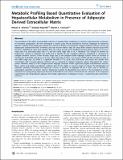| dc.contributor.author | Sharma, Nripen S. | |
| dc.contributor.author | Nagrath, Deepak | |
| dc.contributor.author | Yarmush, Martin Leon | |
| dc.date.accessioned | 2011-12-24T18:09:27Z | |
| dc.date.issued | 2011 | |
| dc.identifier.citation | Sharma, Nripen S., Deepak Nagrath, and Martin L. Yarmush. 2011. Metabolic profiling based quantitative evaluation of hepatocellular metabolism in presence of adipocyte derived extracellular matrix. PLoS ONE 6(5): e20137. | en_US |
| dc.identifier.issn | 1932-6203 | en_US |
| dc.identifier.uri | http://nrs.harvard.edu/urn-3:HUL.InstRepos:5978690 | |
| dc.description.abstract | The elucidation of the effect of extracellular matrices on hepatocellular metabolism is critical to understand the mechanism of functional upregulation. We have developed a system using natural extracellular matrices [Adipogel] for enhanced albumin synthesis of rat hepatocyte cultures for a period of 10 days as compared to collagen sandwich cultures. Primary rat hepatocytes isolated from livers of female Lewis rats recover within 4 days of culture from isolation induced injury while function is stabilized at 7 days post-isolation. Thus, the culture period can be classified into three distinct stages viz. recovery stage [day 0 to 4], pre-stable stage [day 5 to 7] and the stable stage [day 8 to 10]. A Metabolic Flux Analysis of primary rat hepatocytes cultured in Adipogel was performed to identify the key metabolic pathways modulated as compared to collagen sandwich cultures. In the recovery stage [day 4], the collagen-soluble Adipogel cultures shows an increase in TriCarboxylic Acid [TCA] cycle fluxes; in the pre-stable stage [day 7], there is an increase in PPP and TCA cycle fluxes while in the stable stage [day 10], there is a significant increase in TCA cycle, urea cycle fluxes and amino acid uptake rates concomitant with increased albumin synthesis rate as compared to collagen sandwich cultures throughout the culture period. Metabolic analysis of the collagen-soluble Adipogel condition reveals significantly higher transamination reaction fluxes, amino acid uptake and albumin synthesis rates for the stable vs. recovery stages of culture. The identification of metabolic pathways modulated for hepatocyte cultures in presence of Adipogel will be a useful step to develop an optimization algorithm to further improve hepatocyte function for Bioartificial Liver Devices. The development of this framework for upregulating hepatocyte function in Bioartificial Liver Devices will facilitate the utilization of an integrated experimental and computational approach for broader applications of Adipogel in tissue e engineering and regenerative medicine. | en_US |
| dc.language.iso | en_US | en_US |
| dc.publisher | Public Library of Science | en_US |
| dc.relation.isversionof | doi:10.1371/journal.pone.0020137 | en_US |
| dc.relation.hasversion | http://www.ncbi.nlm.nih.gov/pmc/articles/PMC3095641/pdf/ | en_US |
| dash.license | LAA | |
| dc.subject | tissue engineering | en_US |
| dc.subject | metabolic networks | en_US |
| dc.subject | biomedical engineering | en_US |
| dc.subject | biotechnology | en_US |
| dc.title | Metabolic Profiling Based Quantitative Evaluation of Hepatocellular Metabolism in Presence of Adipocyte Derived Extracellular Matrix | en_US |
| dc.type | Journal Article | en_US |
| dc.description.version | Version of Record | en_US |
| dc.relation.journal | PLoS ONE | en_US |
| dash.depositing.author | Yarmush, Martin Leon | |
| dc.date.available | 2011-12-24T18:09:27Z | |
| dash.affiliation.other | HMS^Health Sciences and Technology | en_US |
| dash.affiliation.other | HMS^Surgery-Massachusetts General Hospital | en_US |
| dc.identifier.doi | 10.1371/journal.pone.0020137 | * |
| dash.contributor.affiliated | Yarmush, Martin | |


